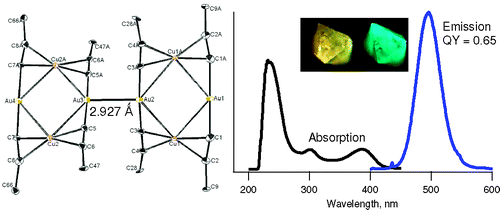当前位置:
X-MOL 学术
›
J. Am. Chem. Soc.
›
论文详情
Our official English website, www.x-mol.net, welcomes your
feedback! (Note: you will need to create a separate account there.)
Luminescent Au(I)/Cu(I) Alkynyl Clusters with an Ethynyl Steroid and Related Aliphatic Ligands: An Octanuclear Au4Cu4Cluster and Luminescence Polymorphism in Au3Cu2Clusters
Journal of the American Chemical Society ( IF 14.4 ) Pub Date : 2010-09-08 , DOI: 10.1021/ja103400e
Gerald F. Manbeck 1 , William W. Brennessel 1 , Robert A. Stockland 1 , Richard Eisenberg 1
Journal of the American Chemical Society ( IF 14.4 ) Pub Date : 2010-09-08 , DOI: 10.1021/ja103400e
Gerald F. Manbeck 1 , William W. Brennessel 1 , Robert A. Stockland 1 , Richard Eisenberg 1
Affiliation

|
Gold(I) bis(acetylide) complexes [PPN][AuR(2)] (1-3) where PPN = bis(triphenylphosphine)iminium) and R = ethisterone (1); 1-ethynylcyclopentanol (2); 1-ethynylcyclohexanol (3) have been prepared. The reaction of 1 with [Cu(MeCN)(4)][PF(6)] in a 1:1 or 3:2 ratio provides the octanuclear complex [Au(4)Cu(4)(ethisterone)(8)] (4) or pentanuclear complex [PPN][Au(3)Cu(2)(ethisterone)(6)] (5). Complexes 2 and 3 react with [Cu(MeCN)(4)][PF(6)] to form only pentanuclear Au(I)/Cu(I) complexes [PPN][Au(3)Cu(2)(1-ethynylcyclopentanol)(6)] (6) and [PPN][Au(3)Cu(2)(1-ethynylcyclohexanol)(6)] (7). X-ray crystallographic studies of 1-3 reveal nontraditional hydrogen bonding between hydroxyl groups and the acetylide units of adjacent molecules. Complexes 6 and 7 each form polymorphs in which the structures (6 a,b and 7 a,b,c) differ by Au...Au, Au...Cu, and Cu-C distances. The polymorphs exhibit different emission energies with colors ranging from blue to yellow in the solid state. In solution, pentanuclear clusters 5-7 emit with lambda(max) = 570-580 nm and Phi = 0.05-0.19. Complex 4 emits at 496 nm in CH(2)Cl(2) with a quantum yield of 0.65. Complex 5 exists in equilibrium with 1 and 4 in the presence of methanol, ethanol, ethyl acetate, or water. This equilibrium has been probed by X-ray crystallography, NMR spectroscopy, and luminescence experiments. DFT calculations have been performed to analyze the orbitals involved in the electronic transitions of 4, 6, and 7.
中文翻译:

带有乙炔类固醇和相关脂肪族配体的发光 Au(I)/Cu(I) 炔基簇:Au3Cu2 簇中的八核 Au4Cu4 簇和发光多态性
金(I)双(乙炔)络合物 [PPN][AuR(2)] (1-3) 其中 PPN = 双(三苯基膦)亚胺)和 R = 乙酮 (1);1-乙炔基环戊醇(2);1-乙炔基环己醇(3)已制备。1 与 [Cu(MeCN)(4)][PF(6)] 以 1:1 或 3:2 的比例反应得到八核络合物 [Au(4)Cu(4)(ethisterone)(8)] (4) 或五核络合物 [PPN][Au(3)Cu(2)(ethisterone)(6)] (5)。配合物 2 和 3 与 [Cu(MeCN)(4)][PF(6)] 反应仅形成五核 Au(I)/Cu(I) 配合物 [PPN][Au(3)Cu(2)(1-乙炔基环戊醇)(6)] (6) 和 [PPN][Au(3)Cu(2)(1-乙炔基环己醇)(6)] (7)。1-3 的 X 射线晶体学研究揭示了羟基与相邻分子的乙炔基单元之间的非传统氢键。配合物 6 和 7 各自形成多晶型物,其中结构(6 a、b 和 7 a、b、c)的不同之处在于 Au...Au、Au...Cu、和 Cu-C 距离。多晶型物在固态时表现出不同的发射能量,颜色范围从蓝色到黄色。在溶液中,五核簇 5-7 发射 lambda(max) = 570-580 nm 和 Phi = 0.05-0.19。配合物 4 在 CH(2)Cl(2) 中以 496 nm 发射,量子产率为 0.65。在甲醇、乙醇、乙酸乙酯或水的存在下,配合物 5 与 1 和 4 处于平衡状态。这种平衡已经通过 X 射线晶体学、核磁共振光谱和发光实验进行了探测。已执行 DFT 计算以分析参与 4、6 和 7 电子跃迁的轨道。配合物 4 在 CH(2)Cl(2) 中以 496 nm 发射,量子产率为 0.65。在甲醇、乙醇、乙酸乙酯或水的存在下,配合物 5 与 1 和 4 处于平衡状态。这种平衡已经通过 X 射线晶体学、核磁共振光谱和发光实验进行了探测。已执行 DFT 计算以分析参与 4、6 和 7 电子跃迁的轨道。配合物 4 在 CH(2)Cl(2) 中以 496 nm 发射,量子产率为 0.65。在甲醇、乙醇、乙酸乙酯或水的存在下,配合物 5 与 1 和 4 处于平衡状态。这种平衡已经通过 X 射线晶体学、核磁共振光谱和发光实验进行了探测。已执行 DFT 计算以分析参与 4、6 和 7 电子跃迁的轨道。
更新日期:2010-09-08
中文翻译:

带有乙炔类固醇和相关脂肪族配体的发光 Au(I)/Cu(I) 炔基簇:Au3Cu2 簇中的八核 Au4Cu4 簇和发光多态性
金(I)双(乙炔)络合物 [PPN][AuR(2)] (1-3) 其中 PPN = 双(三苯基膦)亚胺)和 R = 乙酮 (1);1-乙炔基环戊醇(2);1-乙炔基环己醇(3)已制备。1 与 [Cu(MeCN)(4)][PF(6)] 以 1:1 或 3:2 的比例反应得到八核络合物 [Au(4)Cu(4)(ethisterone)(8)] (4) 或五核络合物 [PPN][Au(3)Cu(2)(ethisterone)(6)] (5)。配合物 2 和 3 与 [Cu(MeCN)(4)][PF(6)] 反应仅形成五核 Au(I)/Cu(I) 配合物 [PPN][Au(3)Cu(2)(1-乙炔基环戊醇)(6)] (6) 和 [PPN][Au(3)Cu(2)(1-乙炔基环己醇)(6)] (7)。1-3 的 X 射线晶体学研究揭示了羟基与相邻分子的乙炔基单元之间的非传统氢键。配合物 6 和 7 各自形成多晶型物,其中结构(6 a、b 和 7 a、b、c)的不同之处在于 Au...Au、Au...Cu、和 Cu-C 距离。多晶型物在固态时表现出不同的发射能量,颜色范围从蓝色到黄色。在溶液中,五核簇 5-7 发射 lambda(max) = 570-580 nm 和 Phi = 0.05-0.19。配合物 4 在 CH(2)Cl(2) 中以 496 nm 发射,量子产率为 0.65。在甲醇、乙醇、乙酸乙酯或水的存在下,配合物 5 与 1 和 4 处于平衡状态。这种平衡已经通过 X 射线晶体学、核磁共振光谱和发光实验进行了探测。已执行 DFT 计算以分析参与 4、6 和 7 电子跃迁的轨道。配合物 4 在 CH(2)Cl(2) 中以 496 nm 发射,量子产率为 0.65。在甲醇、乙醇、乙酸乙酯或水的存在下,配合物 5 与 1 和 4 处于平衡状态。这种平衡已经通过 X 射线晶体学、核磁共振光谱和发光实验进行了探测。已执行 DFT 计算以分析参与 4、6 和 7 电子跃迁的轨道。配合物 4 在 CH(2)Cl(2) 中以 496 nm 发射,量子产率为 0.65。在甲醇、乙醇、乙酸乙酯或水的存在下,配合物 5 与 1 和 4 处于平衡状态。这种平衡已经通过 X 射线晶体学、核磁共振光谱和发光实验进行了探测。已执行 DFT 计算以分析参与 4、6 和 7 电子跃迁的轨道。







































 京公网安备 11010802027423号
京公网安备 11010802027423号